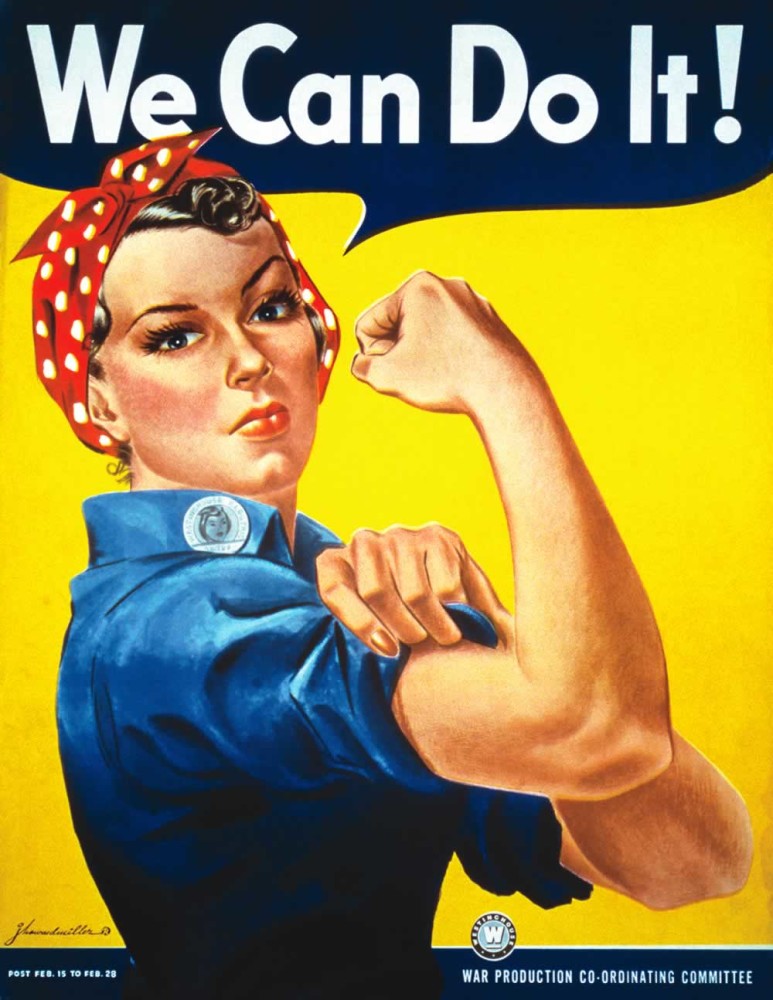By Steve Campbell
Fort Worth Star-Telegram.
FORT WORTH
Fleeing rural poverty in Kentucky, Rose Will Monroe piled her son and daughter into a bus in 1942, not long after her husband was killed in a car wreck.
Monroe was determined to find work at the Willow Run airplane plant in Ypsilanti, Mich. She wanted to fly, but with two kids, the military kept the 22-year-old widow on the ground.
So Monroe, a “tomboy” daughter of a carpenter, went to work wielding a 6.8-pound rivet hammer on the mammoth assembly line devised by Henry Ford to produce B-24 bombers.
Monroe was just one of 6 million American women who entered the workforce during World War II, about half of them in the defense industries.
But she came to represent them all.
Through a confluence of circumstances, Monroe became “Rosie the Riveter,” the iconic image of the tough, hardworking American woman who helped win the war.
Vicki Croston of Conroe, Monroe’s surviving child, who was born in 1954, now tells her mother’s story. And on Thursday, she spoke to a roomful of modern “Rosie the Riveters.”
‘We Can Do It’
Fort Worth is a long way from Ypsilanti, where Monroe and her co-workers built 8,685 bombers, or one about every 56 minutes during the war.
But “Rosies” here helped perform a similar feat, building 1,803 planes at Consolidated Vultee Aircraft’s bomber plant, which is now Lockheed Martin.
About 30,000 people worked in the plant during the war, but Lockheed Martin officials aren’t sure how many were women.
“Rosie the Riveter” was actually a composite of the experience of many women. The symbol was first popularized by a song, and “Rosie” soon came to represent all women working in defense.
“There were quite a few faces of Rosie,” said Croston, who spoke at Lockheed Martin in honor of Women’s History Month.
One of the most recognizable is Geraldine Hoff Doyle, who was the strong-armed model for the “We Can Do It” poster produced by the Westinghouse Corp.
But Doyle, a cellist, worked only a few weeks in a defense plant, stopping when she realized how easily it could damage her hands and music career, Croston said.
The striking poster was little-known during the war, but it rose to prominence in the early 1980s when the feminist movement adopted it as a potent symbol of empowerment.
Rose Monroe became the best-known “Rosie” after she starred in a series of promotional films designed to sell war bonds.
In 1944, she was discovered by the actor Walter Pidgeon, who visited Willow Run to shoot footage. When he learned that there really was a riveter named Rose on the job, he made her a showpiece of his films.
“She had the right name, the right job and was in the right place at the right time. You can’t plan that,” Croston said.
But there was nothing glamorous about the hard work. During the week, her son and daughter stayed at a co-worker’s home and she lived in a workers’ barracks at the plant.
Monroe never profited from her “Rosie” role. She just considered it her patriotic duty, Croston said.
Monroe worked at the plant for two years before going back home. She had a variety of jobs before becoming a home builder in the 1970s in southern Indiana.
She also lived out her dream of flying. In 1972, she got her pilot’s license and then taught her daughter to fly.
In 1978, Monroe was in a plane accident that resulted in the loss of a kidney. That injury contributed to her death in 1997, Croston said.
Modern ‘Rosies’
Monroe’s story is inspiring for today’s “Rosies” at Lockheed Martin, said Gayle Roland, a senior procurement manager.
“This is all so relevant to me. I’ve riveted. I did that at my first job. But I can’t imagine what those women were doing,” she said.
“They were so willing to pitch in and help. That patriotism is so amazing. That strong human will to support the war effort is beyond anything that I can fathom,” Roland said.
The “Rosies” also pioneered the path for women in defense industries.
Today, 2,667 women are part of Lockheed Martin’s workforce of 12,500 in west Fort Worth, said Ken Ross, director of communications.
Among them are Lorraine Martin, the F-35 program manager in Fort Worth, and Janet Nash, vice president for F-35 production. And everyone at Lockheed works for another woman, Marillyn Hewson, who took over as CEO of the Bethesda, Md.-based corporation last year.
For Nash, the connection to women like Monroe isn’t just professional — it’s personal.
Nash’s grandmother was a “Rosie,” who filed metal burrs off parts in a defense plant.
“The work they did was incredible. Can you imagine holding that 6.8-pound rivet hammer for eight hours?” said Nash, noting that a modern rivet hammer weighs 2.5 pounds.
“Those Rosies, when they went home, they were tired,” said Nash, who has risen through the ranks at Lockheed since starting as an industrial engineer 32 years ago.
Today, she is one of 12 female vice presidents, supervising about 2,000 people who work on the plant’s more than mile-long F-35 production line.
“Women’s roles in aerospace have changed a lot since I started. I was the first female production vice president in this company.
You hold a responsibility when you are the first of something to make sure you do the right things,” Nash said.
That’s what all those “Rosies” were doing, Croston said.
“They did what I don’t know that we could do today,” she said.














































































































































































































































































































































































